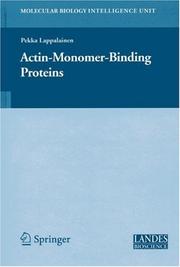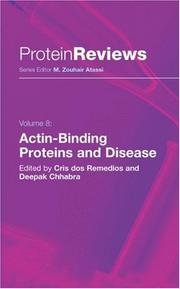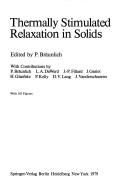| Listing 1 - 10 of 29 | << page >> |
Sort by
|
Book
Year: 2020 Publisher: Frontiers Media SA
Abstract | Keywords | Export | Availability | Bookmark
 Loading...
Loading...Choose an application
- Reference Manager
- EndNote
- RefWorks (Direct export to RefWorks)
The coordinated action of the different cytoskeletal polymers--microtubules, actin filaments and neurofilaments-- is essential for the establishment, remodeling and maintenance of neuronal architecture throughout the neuron lifetime. Neurons are among the most polarized cells, with a long thin axon and multiple thicker and shorter dendrites. Achieving this complex morphology, and the precise and accurate formation of an intricate network of synaptic contacts is critical for the proper transmission and reception of signals in the brain. Neuronal polarization precedes axon outgrowth and the subsequent differentiation of short neurites into dendrites, as part of the neuronal differentiation program that involves both intrinsic and extrinsic signals that converge at the cytoskeletal level. Growth cones, which are sensory and locomotor structures located at the tip of growing axons, are key elements in the transduction of extracellular cues into cytoskeletal changes, guiding axons to their right destinations. Neuronal migration, another crucial process during brain development, occurs in close coordination with neuronal differentiation. Migration involves as well an extensive rearrangement of neuronal cell shape that relies on cytoskeleton reorganization. Further processes, such as dendritic spine formation and growth, establishment of synaptic contacts or synaptic plasticity in mature neurons also depend on cytoskeletal dynamics. Fine-tune regulation of neuronal cytoskeleton is therefore crucial for the maintenance of neuronal integrity and functionality. Mutations in genes that code for cytoskeletal proteins often have deleterious effects in neurons, such as abnormal migration or differentiation, deficient axonal transport of organelles and synaptic vesicles, or impaired synaptic signaling. Several human Nervous System disorders, including neurodevelopmental, psychiatric, and neurodegenerative diseases, have been linked to cytoskeletal dysfunction. Cytoskeletal reorganization is also crucial to regulate nerve cell repair following Nervous System injury. Many of the pathways that control cell-intrinsic axon regeneration lead to axon cytoskeletal remodeling. Moreover, most extracellular cues that inhibit regeneration of damaged axons in Central Nervous System following traumatic injury or neurodegeneration, are known to modulate cytoskeletal dynamics and organization. Based on these findings, regulators of cytoskeleton dynamics have emerged as promising therapeutic targets in several brain disorders and in the context of regeneration of injured axons. Hence, remodeling of neuronal cytoskeleton underlies all the dramatic morphological changes that occur in developing and adult neurons. Understanding the specific molecular mechanisms that control cytoskeleton rearrangements in neurons is far from complete. This Frontiers Research Topic gathers a selection of articles focused on the diverse and key roles of cytoskeleton in neuronal biology.
neuronal cytoskeleton --- astrocyte cytoskeleton --- microtubules (MTs) --- actin cytoskeleton --- tau --- neuron
Book
Year: 2017 Publisher: Frontiers Media SA
Abstract | Keywords | Export | Availability | Bookmark
 Loading...
Loading...Choose an application
- Reference Manager
- EndNote
- RefWorks (Direct export to RefWorks)
The present E-book, consisting of a compilation of original articles and reviews, presents how myofilaments are regulated in cardiac and skeletal muscles and trigger contraction. Additionally, this E-book gives insights into their dysregulation in a number of muscle disorders.
Heart --- Actin --- Myosin --- Muscle --- skeletal muscle --- Contraction --- sarcomere --- Myopathy
Book
ISBN: 9781621003021 1621003027 9781621001911 1621001911 Year: 2012 Publisher: New York
Abstract | Keywords | Export | Availability | Bookmark
 Loading...
Loading...Choose an application
- Reference Manager
- EndNote
- RefWorks (Direct export to RefWorks)
Actin --- Tumors --- Respiratory infections --- Actomyosin --- Respiratory organs --- Respiratory tract infections --- Upper respiratory infections --- Upper respiratory tract infections --- Infection --- Neoplasms --- Tumours --- Pathology --- Cysts (Pathology) --- Oncology --- Physiology. --- Ultrastructure. --- Pathophysiology. --- Infections --- Diseases --- Actins
Book
Year: 2021 Publisher: Basel, Switzerland MDPI - Multidisciplinary Digital Publishing Institute
Abstract | Keywords | Export | Availability | Bookmark
 Loading...
Loading...Choose an application
- Reference Manager
- EndNote
- RefWorks (Direct export to RefWorks)
“Symmetry Breaking in Cells and Tissues” presents a collection of seventeen reviews, opinions and original research papers contributed by theoreticians, physicists and mathematicians, as well as experimental biologists, united by a common interest in biological pattern formation and morphogenesis. The contributors discuss diverse manifestations of symmetry breaking in biology and showcase recent developments in experimental and theoretical approaches to biological morphogenesis and pattern formation on multiple scales.
actin waves --- curved proteins --- dynamic instability --- podosomes --- diffusion --- cell polarity --- Cdc42 --- stress --- cellular memory --- phase separation --- prions --- apoptotic extrusion --- oncogenic extrusion --- contractility --- actomyosin --- bottom-up synthetic biology --- motor proteins --- pattern formation --- self-organization --- cell motility --- signal transduction --- actin dynamics --- intracellular waves --- polarization --- direction sensing --- symmetry-breaking --- biphasic responses --- reaction-diffusion --- membrane and cortical tension --- cell fusion --- cortexillin --- cytokinesis --- Dictyostelium --- myosin --- symmetry breaking --- cytoplasmic flow --- phase-space analysis --- nonlinear waves --- actin polymerization --- bifurcation theory --- mass conservation --- spatial localization --- activator–inhibitor models --- developmental transitions --- cell polarization --- mathematical model --- fission yeast --- reaction–diffusion model --- small GTPases --- Cdc42 oscillations --- pseudopod --- Ras activation --- cytoskeleton --- chemotaxis --- neutrophils --- natural variation --- modelling --- activator-substrate mechanism --- mass-conserved models --- intracellular polarization --- partial differential equations --- sensitivity analysis --- GTPase activating protein (GAP) --- fission yeast Schizosaccharomyces pombe --- CRY2-CIBN --- optogenetics --- clustering --- positive feedback --- network evolution --- Saccharomyces cerevisiae --- polarity --- modularity --- neutrality --- n/a
Book
ISBN: 1441973672 9786612971211 1441973680 1282971212 Year: 2011 Publisher: New York : Springer,
Abstract | Keywords | Export | Availability | Bookmark
 Loading...
Loading...Choose an application
- Reference Manager
- EndNote
- RefWorks (Direct export to RefWorks)
Neurons are characterized by a complex, dynamic and highly polarized morphology. Actin and its regulatory proteins are the most abundant set of proteins within cells, and they form one of the major cytoskeletal systems—the actin filament cytoskeleton. While much has been learned about the roles of the actin cytoskeleton in non-neuronal cells, our understanding of the full spectrum of the functions of actin in neurons is far from complete. This book is an introduction to the interface between the actin cytoskeleton and the myriad of issues fundamental to the understanding of nervous system function. Neurobiology of Actin: From Neurulation to Synaptic Function opens with a chapter that presents the fundamental concepts required to appreciate the details of the molecular machinery that regulates actin in a cellular context, setting the stage for the first part of the book which reviews the neurobiology of actin at the cellular level. The second section of the book then discusses the functions of actin in the context of neurobiological issues ranging from early development to synaptic function and disease states of the nervous system. This text is intended for neuroscientists interested in investigating the actin cytoskeleton in the context of their particular neuroscience research program, and its chapters are cross-referenced in order to assist readers in finding relevant information that is covered in greater depth in other chapters.
Actin. --- Neurobiology. --- Neurophysiology. --- Actin --- Neurobiology --- Neurophysiology --- Muscle Proteins --- Biological Science Disciplines --- Microfilament Proteins --- Cytoskeletal Proteins --- Biopolymers --- Natural Science Disciplines --- Contractile Proteins --- Actins --- Physiology --- Proteins --- Polymers --- Disciplines and Occupations --- Amino Acids, Peptides, and Proteins --- Macromolecular Substances --- Chemicals and Drugs --- Human Anatomy & Physiology --- Health & Biological Sciences --- Neuroscience --- Animal Biochemistry --- Neurophisiology. --- Life sciences. --- Neurosciences. --- Proteins. --- Cell membranes. --- Life Sciences. --- Receptors. --- Membrane Biology. --- Neurosciences --- Actomyosin --- Cell receptors. --- Cell surfaces --- Cytoplasmic membranes --- Plasma membranes --- Plasmalemma --- Membranes (Biology) --- Glycocalyces --- Cell membrane receptors --- Cell surface receptors --- Receptors, Cell --- Binding sites (Biochemistry) --- Cell membranes --- Neural sciences --- Neurological sciences --- Medical sciences --- Nervous system --- Proteins . --- Cell membranes . --- Proteids --- Biomolecules --- Polypeptides --- Proteomics

ISBN: 1281512982 9786611512989 0387464077 0387464050 Year: 2007 Publisher: New York, NY : Springer New York : Imprint: Springer,
Abstract | Keywords | Export | Availability | Bookmark
 Loading...
Loading...Choose an application
- Reference Manager
- EndNote
- RefWorks (Direct export to RefWorks)
The actin cytoskeleton plays a central role in many cellular processes including cell motility, cytokinesis, endocytosis and phagocytosis. The structure and dynamics of the actin cytoskeleton is regulated by a large number of proteins that interact with monomeric and/or filamentous actin. Actin monomer binding proteins provides a comprehensive view on actin monomer-binding proteins and the mechanisms by which they contribute to actin dynamics and various actin-dependent cellular processes. This new title contains chapters that describe the basic mechanisms of actin dynamics as well as the structural principles by which various actin-binding proteins interact with actin.
Actin. --- Carrier proteins. --- Binding proteins --- Transport proteins --- Biological transport --- Protein binding --- Proteins --- Actomyosin --- Cytology. --- Biochemistry. --- Cell Biology. --- Biochemistry, general. --- Biological chemistry --- Chemical composition of organisms --- Organisms --- Physiological chemistry --- Biology --- Chemistry --- Medical sciences --- Cell biology --- Cellular biology --- Cells --- Cytologists --- Composition --- Cell biology.

ISBN: 1281216933 9786611216931 0387717498 0387717471 1441924531 Year: 2008 Volume: v. 8 Publisher: New York : Springer,
Abstract | Keywords | Export | Availability | Bookmark
 Loading...
Loading...Choose an application
- Reference Manager
- EndNote
- RefWorks (Direct export to RefWorks)
This volume, written by experts in the field, is the first to deal with the relationship between human disease and the actin cytoskeleton. It provides overviews of actin and selected actin-binding proteins, and then focuses on diseases that involve these proteins. Specific chapters deal with actin, cofilin, profilin, gelsolin and thymosin ¾4. Other chapters discuss the roles of multiple actin-binding proteins in cancer and metastasis, leukocyte disorders, and heart failure, and there is a chapter that describes how intracellular pathogens use the host actin cytoskeleton. This seminal volume is intended for researchers, clinicians, physicians, and graduate students in the fields of biochemistry, cell biology, microbiology, immunology, and genetics.
Microfilament proteins --- Diseases. --- Pathophysiology. --- Human beings --- Illness --- Illnesses --- Morbidity --- Sickness --- Sicknesses --- Medicine --- Epidemiology --- Health --- Pathology --- Sick --- Actin-binding proteins --- Cytoskeletal proteins --- Diseases --- Cytology. --- Proteomics. --- Biochemistry. --- Cell Biology. --- Protein Science. --- Biochemistry, general. --- Biological chemistry --- Chemical composition of organisms --- Organisms --- Physiological chemistry --- Biology --- Chemistry --- Medical sciences --- Molecular biology --- Proteins --- Cell biology --- Cellular biology --- Cells --- Cytologists --- Composition --- Cell biology. --- Proteins . --- Proteids --- Biomolecules --- Polypeptides --- Proteomics
Book
ISBN: 9811374503 981137449X Year: 2019 Publisher: Singapore : Springer Singapore : Imprint: Springer,
Abstract | Keywords | Export | Availability | Bookmark
 Loading...
Loading...Choose an application
- Reference Manager
- EndNote
- RefWorks (Direct export to RefWorks)
This book discusses in detail the structural, evolutionary and functional role of actin and its regulatory proteins in gliding motility in apicomplexan organisms, a unique phenomenon found in actin-myosin cytoskeletal elements. The book also explores the potential of different actin regulators, namely formin, profilin, actin depolymerization factor (ADF), capping proteins (CPα and CPβ), cyclase-associated protein (CAP) and coronin 13–24 as potential drug targets against malaria. As the chief components of the gliding motor, the actin-regulator proteins are characterized by unique features that make them promising targets for structure-based drug design. Lastly, the book proposes a mathematical model, based on kinetic data mining, to help understand the most vital regulators for actin polymerization dynamics.
Parasitology. --- Biomechanics. --- Proteins . --- Bioinformatics. --- Protein Science. --- Protein Structure. --- Bio-informatics --- Biological informatics --- Biology --- Information science --- Computational biology --- Systems biology --- Proteids --- Biomolecules --- Polypeptides --- Proteomics --- Biological mechanics --- Mechanical properties of biological structures --- Biophysics --- Mechanics --- Contractility (Biology) --- Data processing --- Actin. --- Actomyosin --- Enginyeria de proteïnes --- Disseny de proteïnes --- Tecnologia de proteïnes --- Enginyeria bioquímica --- Enginyeria genètica
Book
Year: 2022 Publisher: Basel MDPI - Multidisciplinary Digital Publishing Institute
Abstract | Keywords | Export | Availability | Bookmark
 Loading...
Loading...Choose an application
- Reference Manager
- EndNote
- RefWorks (Direct export to RefWorks)
This collection of review articles describes the structure, function and mechanism of individual protein methyltransferase enzymes including protein lysine methyltransferases, protein arginine methyltransferases, and also the less abundant protein histidine methyltransferases and protein N-terminal end methyltransferases. The topics covered in the individual reviews include structural aspects (domain architecture, homologs and paralogs, and structure), biochemical properties (mechanism, sequence specificity, product specificity, regulation, and histone and non-histone substrates), cellular features (subcellular localization, expression patterns, cellular roles and function, biological effects of substrate protein methylation, connection to cell signaling pathways, and connection to chromatin regulation) and their role in diseases. This review book is a useful resource for scientists working on protein methylation and protein methyltransferases and those interested in joining this emerging research field.
protein lysine methylation --- H3K9 methylation --- PKMT --- enzyme specificity --- enzyme regulation --- heterochromatin --- protein post-translational modification --- NSD3 --- WHSC1L1 --- structure and function --- protein arginine methylation --- PRMT7 --- epigenetics --- cancer --- immunity --- pluripotency --- SETDB1 --- methyltransferase --- schizophrenia --- Huntington’s disease --- Rett syndrome --- Prader–Willi syndrome --- congenital heart diseases --- inflammatory bowel disease --- MLL2 --- structure --- H3K4me3 --- chromatin regulation --- disease --- dystonia --- NSD1 --- H3K36 --- SOTOS --- NUP98-NSD1 --- AML --- PRMT6 --- post-translational modification --- H3R2me2a --- SETD3 --- posttranslational modifications --- protein histidine methylation --- actin --- polymerization --- cytoskeleton --- enteroviruses --- oncogenesis --- PRMT5 --- cardiovascular disease --- neurodegenerative diseases --- diabetes --- inflammation --- G9a --- GLP --- EHMT2 --- EHMT1 --- post translational modification --- lysine methylation --- N-terminal methylation --- translation --- eEF1A --- METTL13 --- neuron --- synapse --- dendritic spine --- actin cytoskeleton --- GTPase --- PRMT1 --- arginine methylation --- H4R3 methylation --- transcriptional regulation --- cell signaling --- DNA damage repair --- PRMT2 --- SH3 --- SETMAR --- Metnase --- H3K36me2 --- Hsmar1 --- non-homologous end joining repair --- NHEJ --- transposase --- transposable elements --- histone --- SET7/9 --- SETD7 --- lysine-specific methyltransferase (PKMT) --- cell proliferation --- stress response --- post-translational protein modification --- n/a --- Huntington's disease --- Prader-Willi syndrome

ISBN: 0387095950 3540095950 3540347976 9783540095958 9780387095950 Year: 1979 Volume: 37 Publisher: Berlin Springer
Abstract | Keywords | Export | Availability | Bookmark
 Loading...
Loading...Choose an application
- Reference Manager
- EndNote
- RefWorks (Direct export to RefWorks)
The coronins, first described in Dictyostelium discoideum in 1991, have been detected in all eukaryotes except plants. They belong to the superfamily of WD40-repeat proteins and represent a large family of proteins, which are often involved in cytoskeletal functions. Phylogenetic studies clearly distinguish 12 subfamilies of which six exclusively occur in vertebrates. In the present book we have made a sincere attempt to provide a comprehensive overview on all aspects of coronin proteins including history, structure, subcellular localization and function in different organisms. In addition, we
Microfilament proteins. --- Actin-binding proteins --- Cytoskeletal proteins --- Exoelectron emission. --- Solids --- Thermally stimulated currents. --- Thermal properties. --- Electronics and optics of solids --- 538.9 --- 538.9 Physics of condensed matter (in liquid state and solid state) --- Physics of condensed matter (in liquid state and solid state) --- Medicine. --- Biomedicine general. --- Clinical sciences --- Medical profession --- Human biology --- Life sciences --- Medical sciences --- Pathology --- Physicians --- Health Workforce --- Monograph --- Biomedicine, general. --- Medicine --- Biology --- Biomedical Research. --- Research. --- Biological research --- Biomedical research
| Listing 1 - 10 of 29 | << page >> |
Sort by
|

 Search
Search Feedback
Feedback About UniCat
About UniCat  Help
Help News
News